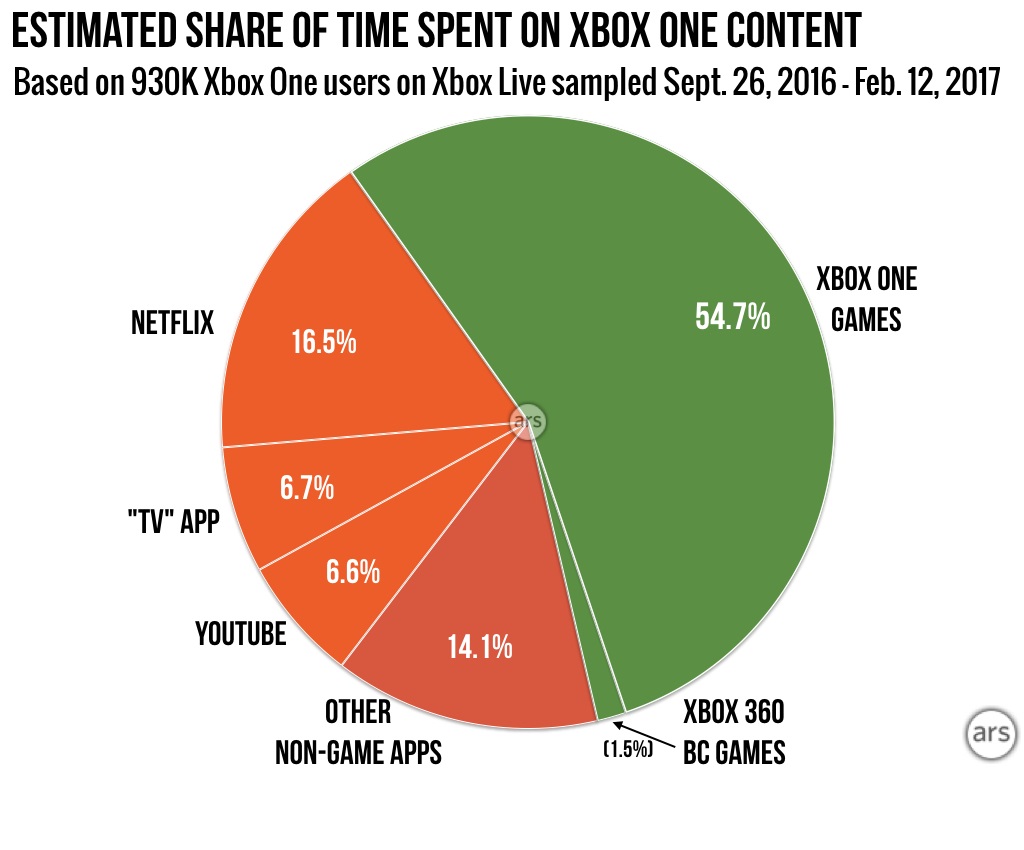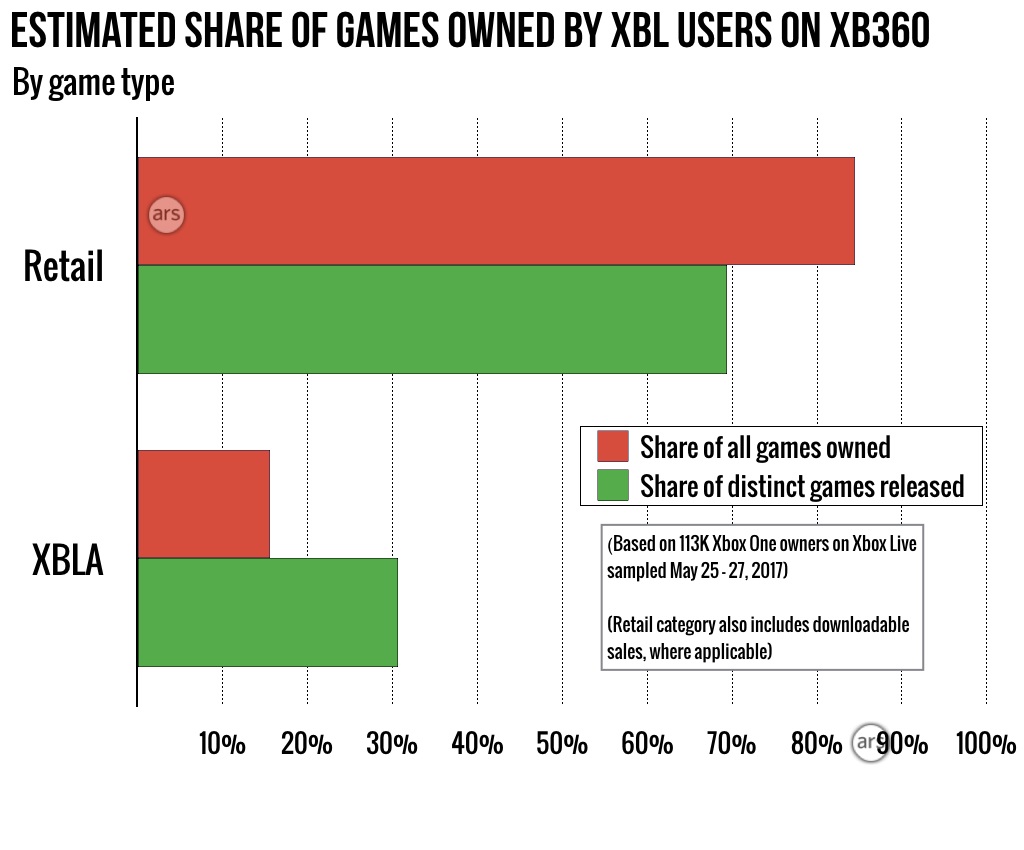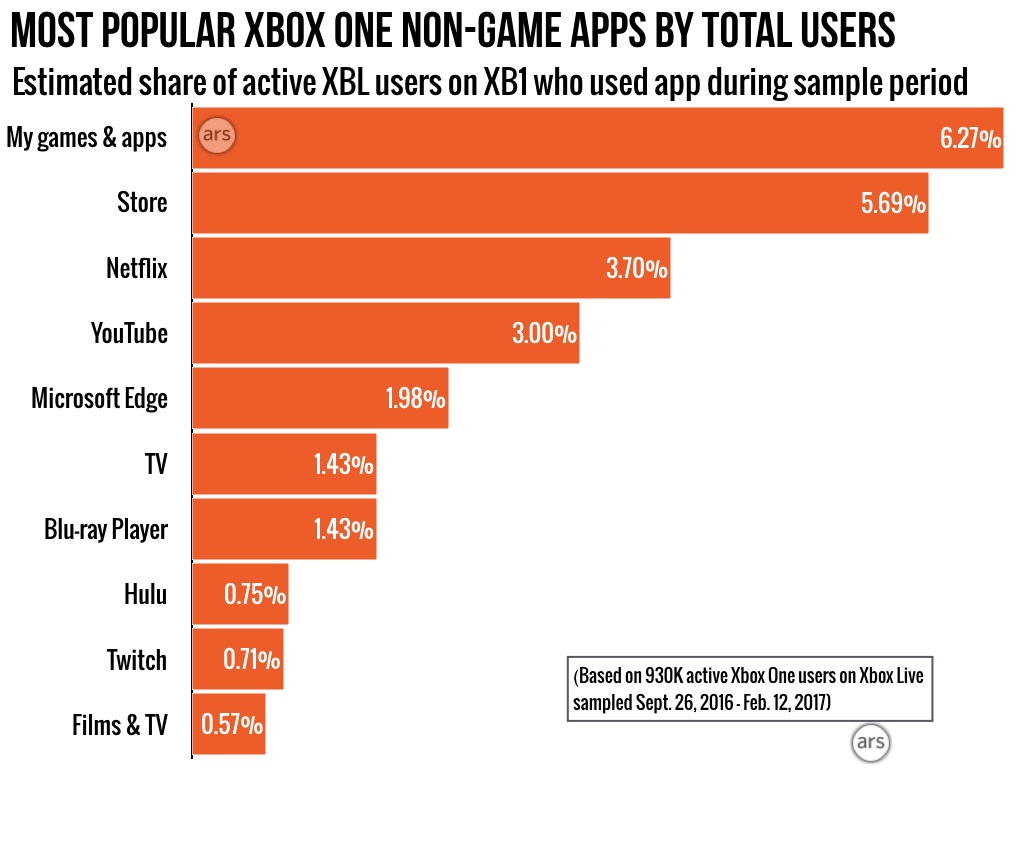Xbox Unleashed: Our deep-dive study of how millions use Xbox Live
For three years now, Ars’ Steam Gauge project and the public sampling projects it has inspired (such as Steam Spy) have provided an important behind-the-scenes look at what kinds of games are popular on PC gaming’s most popular marketplace. Today, after years of work, we’re ready to unveil a new effort that similarly uncovers what’s popular among Xbox Live users on the Xbox One and Xbox 360.
As we introduce you to our data and our methodology, you probably won’t be surprised to see the enduring popularity of franchises like Call of Duty, Grand Theft Auto, and Halo on Microsoft’s platforms. You might be more surprised by just how often the average Xbox console is used as nothing more than a streaming video box, or by how a relative handful of games dominate the total play time spent on both consoles, or by the specific, branded Xbox 360 adver-game that still sees relatively significant play years after its release.
We’re just beginning to play with all the data about Xbox Live users we now have at our disposal. But first, a little about where that data comes from.
Opening the box
Shortly after I published my first Steam Gauge analysis, I realized something similar might be possible for the world of Xbox Live. You might not realize it, but Microsoft generates a list of every game that’s owned by every public Xbox Live account, and that list can be easily accessed by anyone who knows the Gamertag in question. You can see this for yourself by navigating to the Profile page for pretty much any arbitrary Gamertag on Xbox.com and clicking the Achievements tab (You’ll need to sign in with your own Xbox Live account to access this page—a free silver account will do).
This listing covers both online and single-player games, and it seems to be updated as soon as the game is first played on the console (Update: We originally said games showed up here as soon as they were purchased digitally. Ars regrets the error). The listing even shows certain PC games that connect to Xbox Live through the Xbox for Windows interface, though we’re not clear which games trigger that as of yet. And while users can decide to block this information from the public in their Xbox Settings, very few seem to go to the trouble.
Microsoft appears to have stopped surfacing this kind of extremely granular Xbox Live usage data sometime in mid-February, which is probably a good thing from a user-privacy perspective. Before the company turned off this data spigot, though, we were able to randomly sample the Xbox-usage activity of hundreds of thousands of active Gamertags over a period of more than four months (see below for more on how we did that sampling). This has allowed us to create a wide-ranging, anonymized, aggregate look at what the average online Xbox 360 and Xbox One owner was actually doing with their systems on a day-to-day basis during that time.
Tagging those Gamertags
With an API data source in place, we only needed one more piece to start generating our sample: a comprehensive list of Xbox Live Gamertags. Unlike Steam, which assigns its users semi-hidden numerical IDs in more-or-less sequential order, the Xbox API only spits out data when given a user’s chosen Gamertag. Getting a complete list of all such Gamertags (or at least a suitably large and representative subset) to sample from was not an insignificant challenge.
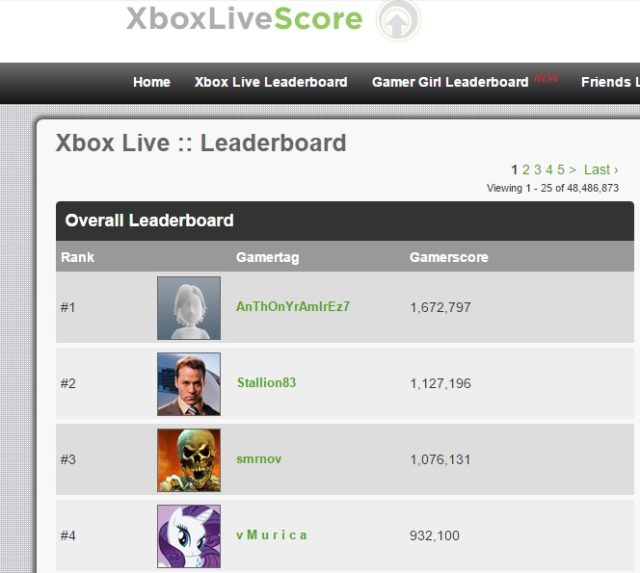
After running this process for many months, our initial list of just over 48 million Gamertags is now approaching 74 million (73,928,903 as of this writing, to be precise). Considering that Microsoft reported only 55 million active Xbox Live users at the beginning of 2017, we feel that’s a pretty good sample space, even accounting for the mass of “inactive” and/or defunct Gamertags that are doubtlessly wasting space in our list.
The numbers and ratios presented in this report should only be considered representative, sampled estimates of the online portion of the Xbox community, which could be significantly different from the total community of Xbox owners. You can try to multiply out our percentages by reported hardware sales numbers if you want, but we wouldn’t stand behind that extrapolation.
Even with these limitations, though, we think these estimates of Xbox usage and game ownership are still superior to the utter lack of information we had about the world of Xbox usage before. Let’s dive into the numbers and see just what they have to say about what’s popular on Microsoft’s consoles these days.
The X stands for NetfliX
Even if you have a vague sense of how popular Netflix is, the actual usage patterns for the app among Xbox Live users is striking (Fig. 1-2). All told, just under 19 percent of all time spent on Xbox Live across both consoles is spent on this one app, according to our sample. That includes a massive 34 percent chunk of all Xbox 360 time, suggesting a whole lot of the aging hardware is still in service primarily to stream House of Cards and its ilk.
Another 7.6 percent of Xbox Live time across both consoles goes to YouTube, meaning more than a quarter of all that Xbox console usage is devoted to just two video apps. On the Xbox One, a significant 6.7 percent chunk of time also goes to simply watching TV through the system’s HDMI input.
The average (mean) active Xbox 360 user in our ~4.5-month sample spent 878.31 minutes on the system, while the average Xbox One user spent 1,526 minutes on the system. All told, our sample captured 1,649,567,509 total minutes of console usage during our sample period, and that’s just from a few hundred thousand users.
Looking past Netflix and YouTube, no individual non-gaming app makes much of an individual impression as far as Xbox Live usage is concerned. Hulu and Amazon make token appearances, but their usage is nothing compared to the top two video juggernauts they’re competing with, at least among Xbox Live users.
The second-most surprising high-level result from our Xbox usage sample is just how unpopular Xbox 360 backward compatibility is in actual practice. Playing games from the previous console accounts for under two percent of total Xbox One usage in our sample. For context, that means the hundreds of backward compatible Xbox 360 games combine to represent less than half of the play time that a game like Grand Theft Auto V manages on its own.
On the Xbox 360 side, we can see that Microsoft’s early experiment with downloadable games through Xbox Live Arcade making a very modest impression on recent gameplay activity. Games available only as downloads account for a paltry 2.3 percent of continued play time in our usage sample. Looking at overall ownership, XBLA games make up about 15.6 percent of all game sales on the system, well under the 30.6 percent of distinct titles represented by the downloadable storefront. That’s not nothing, but it suggests games available at retail were (and are) driving the vast bulk of interest in the Xbox 360.
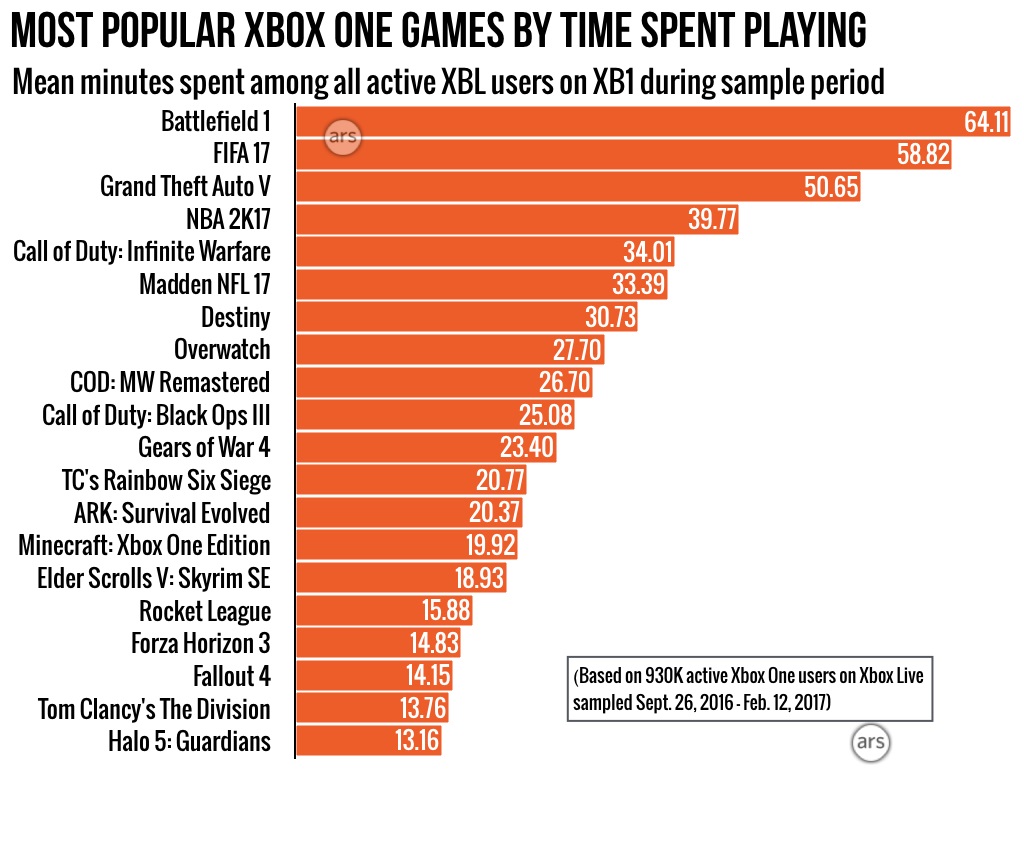
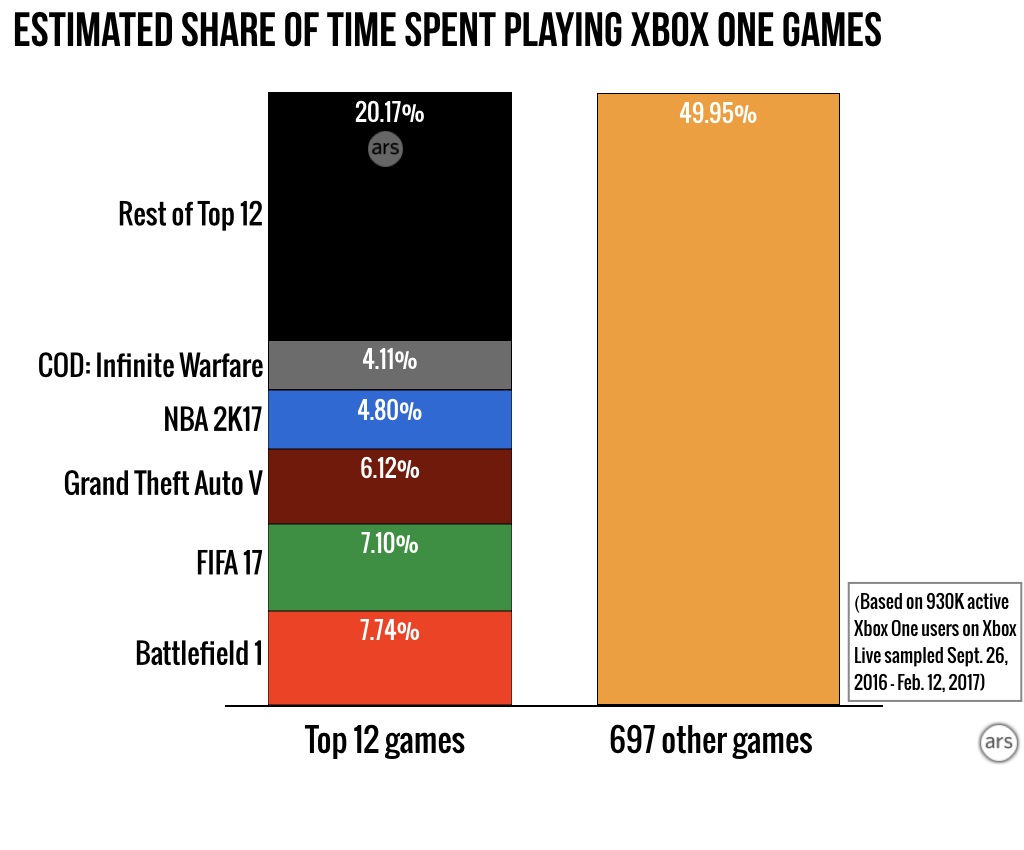
A list of the most played games on the Xbox One and Xbox 360 ends up look depressingly homogenous in our sample. First- and third-person shooters make up a significant majority of the top-ranked titles, with a few odd sports games and epic fantasy RPGs rounding out the lists. Minecraft is the most noticeable exception on both Top 20 lists, though whether that’s a cause or an effect of Microsoft’s $2.5 billion buyout of Mojang is an open question.
If you’re hoping the remainder of the Xbox library will show some hidden variety in Xbox Live users’ playing habits, think again. The top handful of games on each console represent a majority of all the time spent playing games in our sample, with the remainder quite quickly diminishing to relative nothingness on an individual play time basis.
On both systems, the top 10 percent of games represent about 90 percent of all measured usage, easily outpacing the 20-80 percent split of the Pareto principle to the benefit of the top-performing titles (Fig. 12-13). When you look at the median game on either system as ranked by total playtime, you're not even registering a percent of a percent of the playtime that the most popular titles enjoy. Separating out games by number of players, rather than the total number of played minutes, doesn't do much to change the basic makeup of the most popular games.
Non-game apps are not captured in this sample, nor is it possible to tell whether applicable Xbox 360 games in this sample are being played on original hardware or through Xbox One backward compatibility. There's also no way to tell precisely when games were actually purchased before our sampling started at the beginning of May. While we use the shorthand "owners" for this measurement, the percentages here probably can't be directly extrapolated to precise sales data, as discussed in the earlier "limitations and caveats" section.
So totally owned
Unsurprisingly, the majority of the "most owned" games on both Xbox systems are titles that also showed a large amount of total play time in a separate sample. Right away, a few games stick out for showing relatively strong ownership numbers despite being played relatively infrequently. Titanfall, Ryse: Son of Rome and Sunset Overdrive, for instance, are ranked 8th, 18th and 19th in total ownership on Xbox One while being ranked 98th, 162nd, and 112th, respectively, in total playtime in the earlier gameplay sample.
This gap suggests these games attracted heavy initial interest and sales success but weren't able to sustain continued player interest into late 2016 and early 2017. That's not too surprising for relatively short single-player games like Ryse and Sunset Overdrive. In the case of Titanfall, many players seem to have moved on to Titanfall 2, which ranks 23rd in total playtime in our sample despite being just 74th in total ownership. We hope to look further into these kinds of gaps in ownership and play time data in future analysis. All three games were also included in various Xbox One console bundles, which might increase the incidence of owner without a lot of play time.


